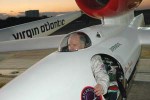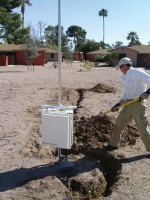When world famous adventurer Steve Fossett's plane disappeared in the maze of peaks and valleys of the Nevada desert, the world was watching. To search the 17,000 square mile area where the plane is believed to have disappeared, multiple satellites combined with an online database allowed the public to examine photographic surveys for evidence of the crash. This unprecedented effort presents a new direction for wireless technology, and related applications are being used to help LTER researchers address large-scale ecological questions.
The use of wireless technology to gather and transmit data from the field to the investigator is on the rise. In the past five years, several LTER sites have installed systems to improve their field observations and enhance the stream of data required for asking larger ecological questions.
As demand grows for broader reaching, more detailed explanations and predictions of ecological phenomena, so does the need for wireless technology.
This article presents a brief survey of wireless technology in use at several LTER sites. More detailed information is available in the references listed below.
At Niwot Ridge (NWT), a site that has been innovative in the use of wireless transmission of meteorological data, more than half a dozen field sites are linked to the Internet and weather data is automatically collected and archived hourly. The near real time data from three stations are graphically displayed on the Niwot LTER web page. The data loggers may be fully manipulated from any Internet-linked computer in the world. The field radio links utilize spread spectrum, frequency-hopping broadband technology originally patented by film legend Hedy Lamarr in 1942.
At the North Temperate Lakes (NTL), wireless sensors are integral to investigating new ecological questions not previously possible. Instrumented buoys equipped with one or more dissolved oxygen sensors, a thermistor chain, and meteorological sensors are deployed on selected lakes to provide fundamental information on lake thermal structure, weather conditions and lake metabolism. Data are usually collected every ten minutes, but with occasional periods of shorter, two-minute intervals to address specific questions.
To many researchers, this may seem like an unwieldy amount of data, and some may question the utility of so much information. "In most cases, the data come in at a rate that is much faster than our current ability to utilize it," says Paul Hanson, NTL LTER investigator. "But if you think that the variable will change in important ways at short time scales, you must have a sensor in the field. And with the use of this data, we are starting to understand that dissolved oxygen could be driven by many factors, such as temperature, biology, or weather fronts, depending on the scale. "There will be a co-evolution of science and technology," Hanson says, "and if we advance the technology we can advance the science as well."
The Konza Prairie (KNZ) LTER site has wireless coverage over a large portion of the research site to stream data from several long-term experiments back to LTER data servers on campus. Information includes meteorological and micrometeorological data, soil temperature and moisture monitoring networks in the rainfall manipulation and irrigation experiments, and from three carbon dioxide flux towers operating at the site, where a wireless cloud allows continuous data streaming to the campus server.
The Sevilleta (SEV), the largest terrestrial LTER site, employs a wireless backbone that covers much of the eastern half of the research area and continues to add sites and experiments that use data loggers to its network. "We are using lots of cool sensor technology that is wired to data loggers," lead investigator Scott Collins says, "then the data are sent wirelessly to our computers and servers," easing the need for excessive labor for data-collection on the large and remote research site.
At the Central Arizona-Phoenix (CAP) site, wireless connections to meteorological stations make data collection easier, saving trips to remote sites. But certain limitations have prevented further deployment of wireless equipment, says CAP researcher, Stevan Earl. "Wireless works well for the climate-related data,"Earl explains, "but physical samples such as insect surveys, measuring plants, and so on, constitute the majority of the data we collect in the field, and currently this can only be done by hand." In addition to the limitations of wireless sensors, the threat of theft is a concern in the CAP urban environment, as a unit recently disappeared from one field site.
While wireless technology presents the tools to address some questions in large-scale ecological research, many challenges remain, such as transmission across hilly terrain or dense vegetation, high costs, and availability of personnel for installation, maintenance, and quality assurance and control of data. Nevertheless wireless technology is critical to the future of LTER technology and might become a required minimum standard installation. "Almost every vendor now has some way of hooking up their equipment wirelessly," says John Porter of the Virginia Coast LTER. In 2003 Porter and colleagues published a pioneering article in BioScience inspired by the use of wireless technology, and they currently are working on a follow up article that will focus on what has been learned using automated and wireless sensors in the field.
More information about international adventurer Steve Fossett: www.stevefossett.com/
More information about inventor Hedy Lamarr: www.inventionconvention.com/americasinventor/dec97issue/section2.html
References:
John Porter, Peter Arzberger, Hans-Werner Braun, Pablo Bryant, Stuart Gage, Todd Hansen, Paul Hanson, Chau-Chin Lin, Fang-Pang Lin, Timothy Kratz, William Michener, Sedra Shapiro, And Thomas Williams. " Wireless Sensor Networks for Ecology." BioScience, vol. 55 No. 7; 561-572.
Scott L. Collins, Luís M. A. Bettencourt, Aric Hagberg, Renee F. Brown, D. I. Moore, Greg Bonito, Kevin A. Delin, Shannon P. Jackson, David W. Johnson, Scott C. Burleigh, Richard R. Woodrow and J. Michael McAuley, “New opportunities in ecological sensing using wireless sensor networks.” Frontiers in Ecology, vol. 4, pp. 402-407.


 Enlarge this image
Enlarge this image

